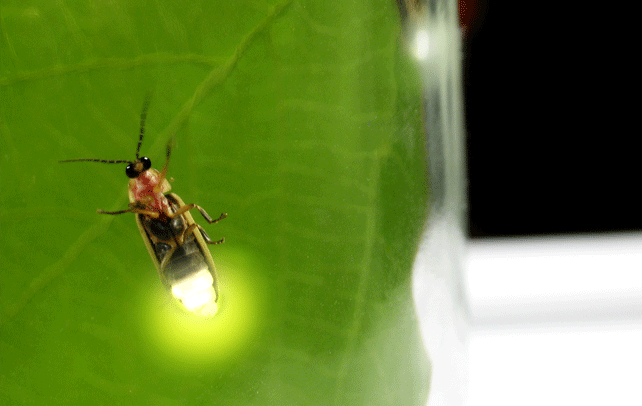Interesting Facts About Fireflies

Lightning bugs, as we commonly know them, fireflies are brown in colour and soft bodied with elytra more leathery than any other species of beetle. When the day ends and the lights fade, these glowing worms appear and roam with their lights on. At some instance they light up while at the other they blink off; it is because of the amount of oxygen intake. These lights are produced to attract mates and preys. The lifecycle of a firefly starts when the female firefly lays eggs after mating. These eggs hatch within three to four weeks and thus the second stage begins: the larvae thus produced feed on snails and slug till summer. After several weeks of feeding, they enter the third stage of their lifecycle, known as pupa. They pupate for almost 10 days and come out as adults. This stage completes the life cycle of a glowworm. Now, let us know some fascinating facts on fireflies.
Fast Facts
Scientific Name: Photuris lucicrescens
Kingdom: Animalia
Phylum: Arthropoda
Class: Insecta
Order: Coleoptera
Family: Lampyridae
Infraclass: Elateriformia
Species: Over 2,000
Shape: Egg-shaped
Diet: Snails,Worms, Nectar and Pollens
Size: 5-20 mm
Weight: 20g
Life Span: About 2 months
Natural Habitat: Wet and Wooded area
Call: Don’t have a call but use light on their abdomen to communicate
Gestation Period: 3-4 weeks
Number of Offspring: Larvae
Interesting And Fun Facts About Fireflies
- There are approximately two thousand species of fireflies that are found in temperate and tropical environments. North America alone has 170 species.
- Fireflies are found on almost every continent except Antarctica.
- In contrast to the popular myth, fireflies are not insects or bugs rather they are a type of beetle. These winged beetles are commonly known as lightning bugs for their glowing tails/ abdomen.
- Scientifically, the chemical reaction known as bioluminescence is the main reason of light emission in fireflies and other glowing species. The chemicals luciferin (pigment) and luciferase (enzyme) produced by fireflies react with oxygen in the presence of calcium ions or ATP to produce light energy.
- The chemicals produced by fireflies are used in forensic and medical tests. The pigment luciferin is used in forensic tests while the medical practitioners use the enzyme luciferase to detect magnesium.
- Fireflies are the only source of 100% natural light as they don’t produce any heat. Some species’ eggs/ larvae also glow that is why they are called as glow-worms, though they are not worms.
- The fireflies found along the river banks of Malaysian jungles synchronize their flashes precisely among large groups at night. It seems like lighting many candles at one place.
- During the first week of June, people visit the Great Smoky Mountains near Elkmont, Tennessee and the Confaree National Park in South Carolina to watch one of the most famous firefly sightings.
- Though fireflies are nocturnal there are some other species that are diurnal in nature.
- Among the diurnal species, the one belonging to the genus Ellychnia don’t produce light at all while those belonging to the genus Lucidota are luminescent and prefer to inhabit in shadowy places.
- Amazingly males can fly but their female counterparts seldom fly as they have shorter wings. They perch on a wall or rock and wait for the male counterparts.
- For mating, the female fireflies attract the male counterparts by their glowing bodies and the male who responds with the best lighting pattern is chosen.
- The fertilized eggs laid by the female firefly on or just below the ground surface hatch after three to four weeks. These hatched larvae are known as glowworms.
- Some larvae of this specie are very specialized predators and they can directly transport digestive fluids on to the prey with the help of their mandibles.
- During winters, the larvae go into hibernation mode. Some make underground burrows while others stay on or under the tree barks.
- The photuris species of fireflies are referred to as femme fatale fireflies as they mimic the mating flashes of female lightning bugs of other genus to seduce their male counterparts. The attracted male fireflies are then eaten by photuris firefly.
- Interestingly, larvae are carnivores as they eat worms, ants and all other arthropods. But at the adult stage, they convert into herbivores and start eating nectars and pollens.
- The main work of adult fireflies is to find mates and lay eggs. After laying eggs in the soil, the larvae feed themselves by eating worms, snails, and ants from the soil. They release a numbing fluid which immobilizes their prey and then they feed on them.
- Firefly is known as the state insect of Pennsylvania, United States of America.
- These insects have been admired in many Japanese poems. They were portrayed as lantern in many poems.
- Some species of fireflies are toxic as they inject some kind of poison into their predator when they bite. So, take care of your pets and don’t let them eat fireflies.









